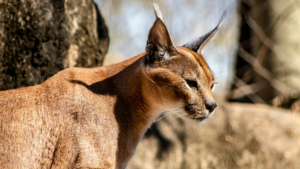
Caracal
A sleek, medium-sized wild cat known for its distinctive ears and remarkable agility
Conservation Status | Near Threatened
The Caracal is a rare and elusive wild cat native to Pakistan’s arid regions. Recognizable by its reddish-gold coat and long black ear tufts, it is adapted to survive in harsh environments. Once more widespread, its numbers have dwindled due to habitat loss and human-wildlife conflict. Caracals are considered low-risk animals when it comes to conservation status, but in Pakistan, they are categorized as new threatened species.
Habitat & Lifestyle
Caracals inhabit dry savannas, woodlands, scrublands, semi-deserts, and mountainous regions. They prefer areas with low rainfall and sufficient cover. Primarily nocturnal and solitary, they are agile hunters, capable of leaping up to 4 meters to catch birds in flight. Their diet includes birds, rodents, hares, and small antelopes. They can survive without direct water sources, obtaining moisture from their prey.
Area Found
In Pakistan, Caracals are found in fragmented populations across:
Cholistan Desert (Punjab)
Hazarganji-Chiltan National Park (Balochistan)
Nara Desert Wildlife Sanctuary (Sindh)
Recent sightings in the Cholistan Desert highlight the importance of ongoing conservation efforts.
Quick Facts
- Size: Body length 70–110 cm; shoulder height approximately 42 cm.
- Weight: 7–20 kg; males are generally larger than females.
- Appearance: Reddish-gold coat with white underparts; long black tufts on ears; no spots or stripes.
- Predators: Few natural predators; threats primarily from humans and habitat loss.
- Unique Fact: Caracals can leap up to 4 meters vertically to catch birds mid-flight and are among the fastest of the small wild cats.




Did you spot a mistake or have more to add? Let us know!
Your feedback helps Haewan keep information accurate and up-to-date.
